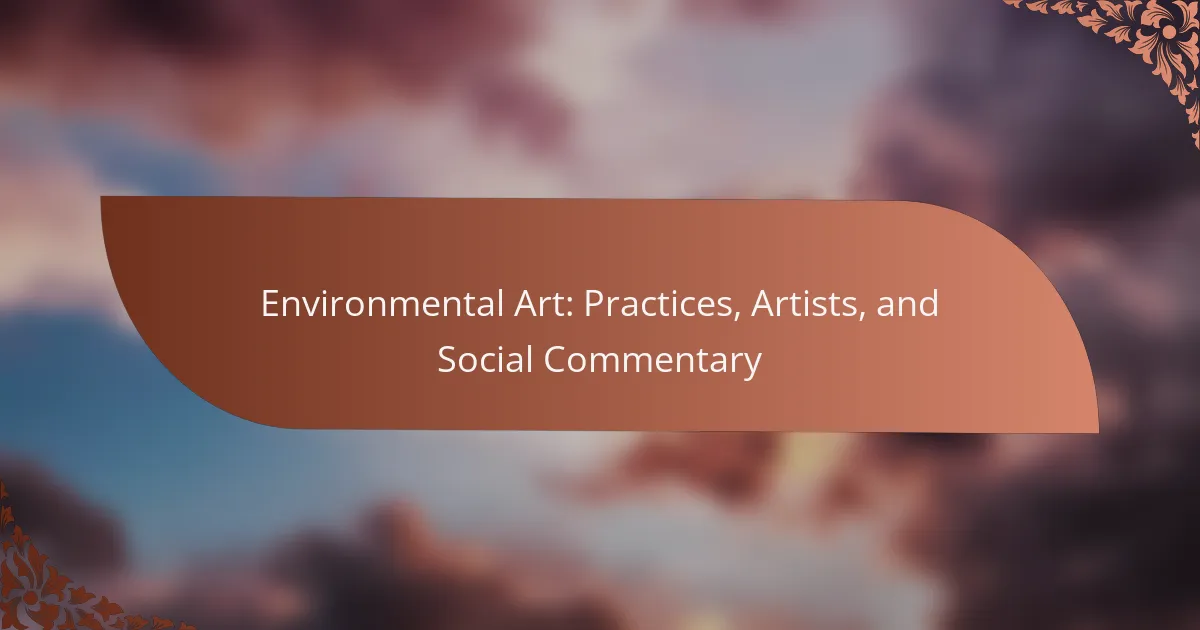Environmental art plays a crucial role in raising awareness about ecological issues and inspiring social change. This article explores practices and notable artists like Olafur Eliasson and Christo and Jeanne-Claude, highlighting their innovative installations. It examines the social commentary embedded in their work, community collaborations, and the cultural perceptions of environmental art. Additionally, it addresses the challenges artists face and future trends in sustainability and technology integration.
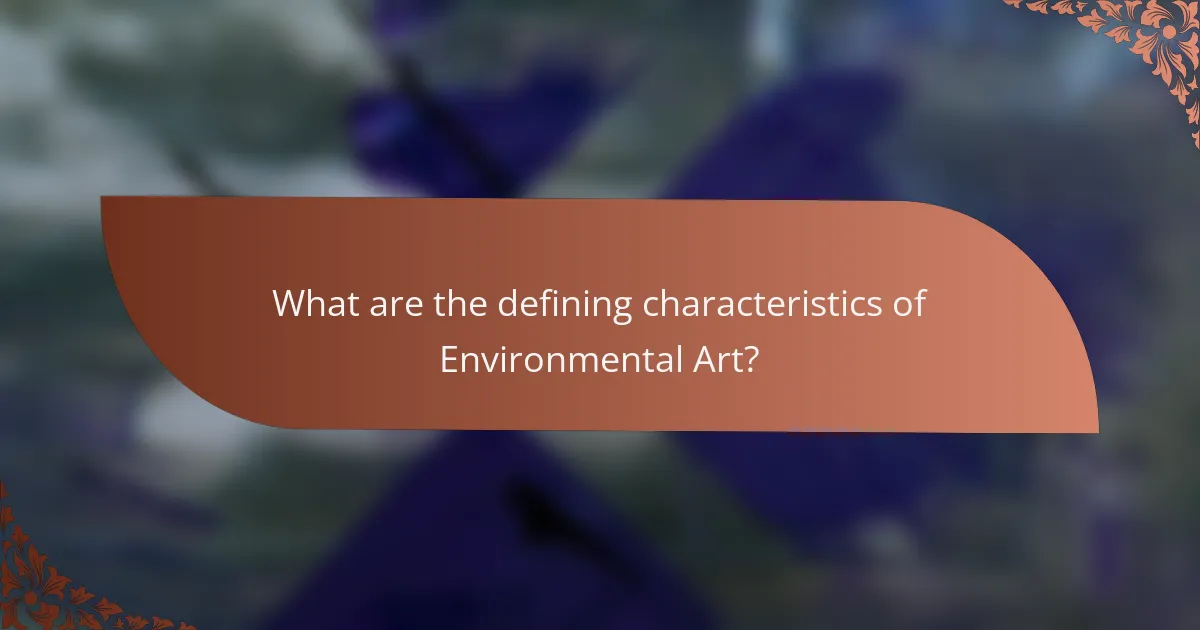
What are the defining characteristics of Environmental Art?
Environmental art is characterized by its integration with nature, social commentary, and community engagement. It often utilizes natural materials and landscapes, emphasizing ecological awareness. Prominent artists like Andy Goldsworthy and Christo and Jeanne-Claude exemplify these practices through their site-specific installations. Environmental art challenges viewers to reconsider their relationship with the environment, fostering a deeper understanding of sustainability and conservation.
How does Environmental Art engage with nature?
Environmental Art engages with nature by creating immersive experiences that highlight ecological issues. Artists use natural materials and processes to foster a connection between people and the environment. This practice often promotes sustainability and raises awareness of environmental challenges. Notable artists like Andy Goldsworthy and Olafur Eliasson exemplify how art can transform perceptions of nature. Their works encourage reflection on humanity’s relationship with the natural world, often integrating site-specific elements that emphasize local ecosystems.
Why is sustainability a core principle in Environmental Art?
Sustainability is essential in Environmental Art as it promotes ecological awareness and responsible practices. This art form often utilizes natural materials, emphasizing the importance of preserving the environment. Artists like Andy Goldsworthy exemplify this approach by creating works that harmonize with nature, highlighting its beauty and fragility. Sustainability in this context serves as both a creative principle and a social commentary, urging audiences to reflect on their relationship with the planet.
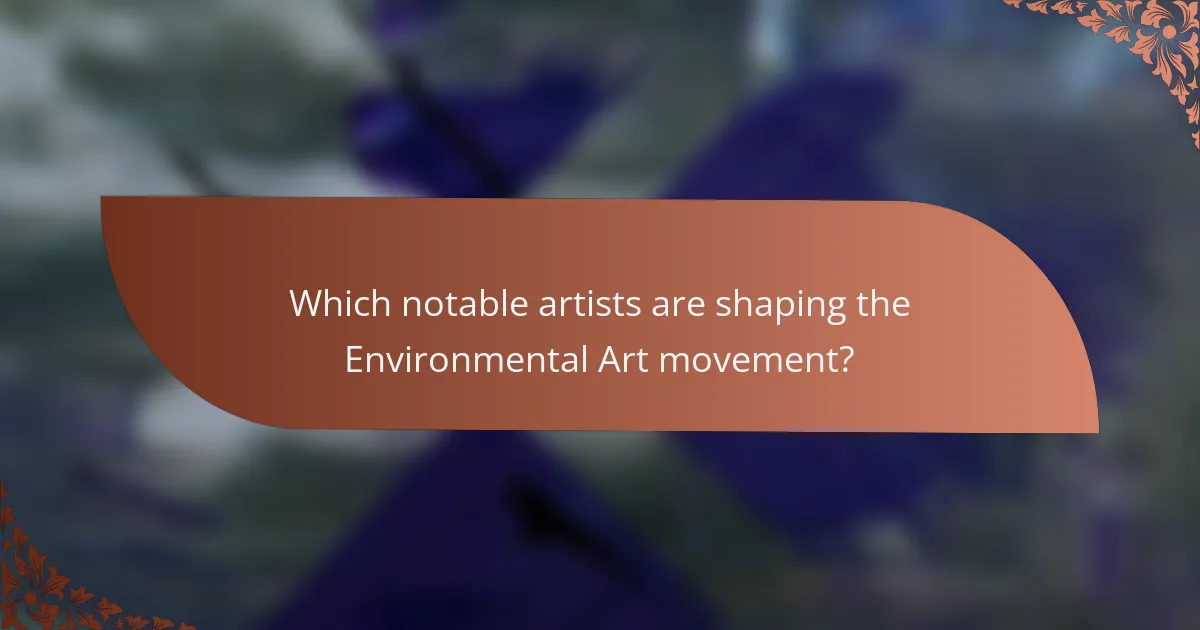
Which notable artists are shaping the Environmental Art movement?
Notable artists shaping the Environmental Art movement include Olafur Eliasson, Agnes Meyer-Brandis, and Chris Jordan. These artists utilize their work to address ecological issues and inspire social change.
Olafur Eliasson creates immersive installations that engage viewers with nature, often using light and water to reflect environmental themes. Agnes Meyer-Brandis focuses on the relationship between humans and nature, often incorporating elements of storytelling and exploration in her art. Chris Jordan uses photography to highlight consumerism’s impact on the environment, showcasing large-scale images that provoke thought about waste and sustainability.
These artists exemplify the movement’s commitment to raising awareness about environmental challenges through innovative and thought-provoking practices.
What unique approaches do artists like Andy Goldsworthy and Agnes Meyer-Brandis use?
Artists like Andy Goldsworthy and Agnes Meyer-Brandis utilize unique, site-specific methods to engage with nature. Goldsworthy creates transient sculptures from natural materials, emphasizing the impermanence of art and nature. His work often responds to the environment, using elements like stones, leaves, and ice to form intricate designs. In contrast, Meyer-Brandis explores the intersection of art, science, and storytelling, often incorporating elements of space and astronomy. Her projects invite viewers to consider their relationship with the cosmos and the environment. Both artists highlight ecological awareness through their innovative approaches.
How do regional influences affect the work of Environmental Artists?
Regional influences significantly shape the work of Environmental Artists by reflecting local cultures, ecosystems, and social issues. Artists often draw inspiration from their surroundings, using materials and themes that resonate with their communities. For instance, coastal artists may focus on marine conservation, while those in urban areas might address pollution and urbanization.
Cultural heritage plays a crucial role, as artists incorporate traditional practices and narratives into their work. This unique attribute fosters a deeper connection with the audience, promoting awareness of environmental challenges specific to the region. Additionally, collaboration with local communities can enhance the impact of the artwork, making it a powerful tool for social commentary and change.
As a result, Environmental Artists not only create visually striking pieces but also engage in activism, influencing public perception and policy regarding environmental issues. Their work serves as a bridge between art and advocacy, highlighting the urgent need for ecological awareness in diverse contexts.
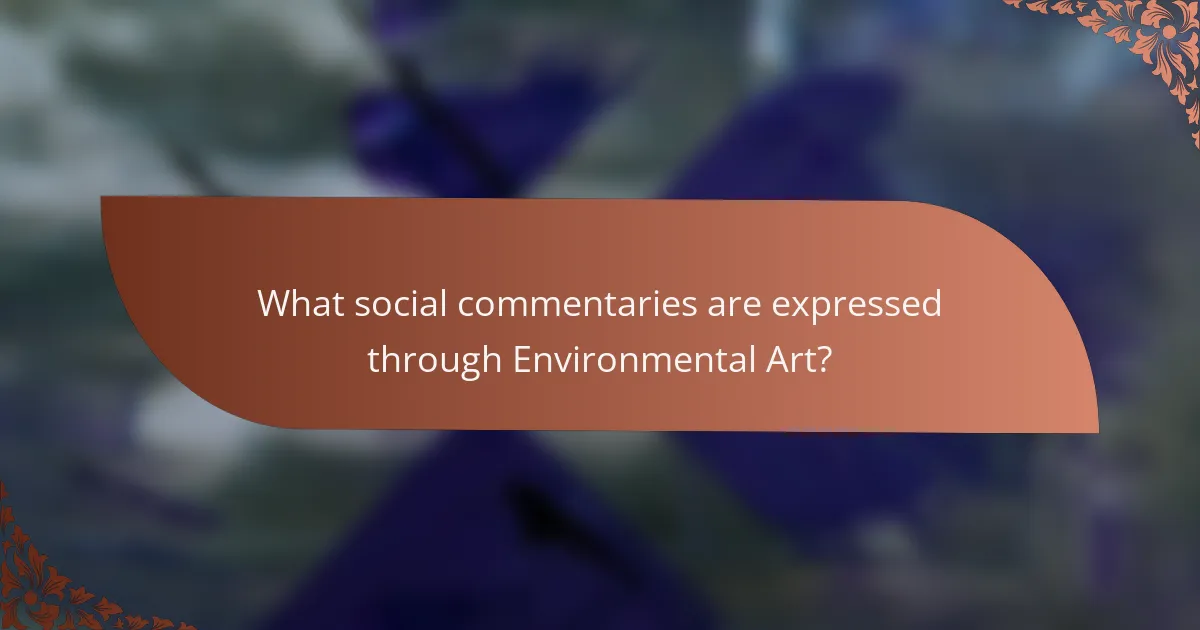
What social commentaries are expressed through Environmental Art?
Environmental art expresses social commentaries on ecological issues, climate change, and human impact on nature. Artists use their work to provoke thought and inspire action regarding environmental sustainability.
For example, installations like Christo and Jeanne-Claude’s “The Gates” in Central Park highlight the relationship between nature and urban life. Similarly, Olafur Eliasson’s “Ice Watch” raises awareness about melting glaciers and climate change. These works often blend aesthetics with activism, urging viewers to reconsider their environmental responsibilities.
Moreover, environmental art often incorporates natural materials, emphasizing the connection between art and the earth. This unique attribute fosters a deeper appreciation for the environment and encourages conversations about conservation.
In summary, environmental art serves as a powerful medium for social commentary, reflecting contemporary concerns and motivating change through artistic expression.
How does Environmental Art address climate change awareness?
Environmental art raises climate change awareness by engaging audiences through visual and interactive experiences. Artists use their work to provoke thought and inspire action on environmental issues. For example, large-scale installations highlight the impact of pollution and deforestation. These artistic expressions often serve as social commentary, encouraging dialogue and community involvement. By blending creativity with activism, environmental art fosters a deeper understanding of climate challenges and promotes sustainable practices.
Why do artists use public spaces for environmental activism?
Artists use public spaces for environmental activism to engage communities and raise awareness about ecological issues. This practice transforms urban landscapes into platforms for dialogue and reflection. Public art installations often highlight the urgency of environmental challenges, making complex topics accessible to a broader audience. For instance, large-scale murals and sculptures can draw attention to climate change, pollution, or biodiversity loss. These artworks can inspire action and foster a sense of collective responsibility towards the environment. By utilizing public spaces, artists create immersive experiences that encourage viewers to reflect on their relationship with nature and the impact of human activities.
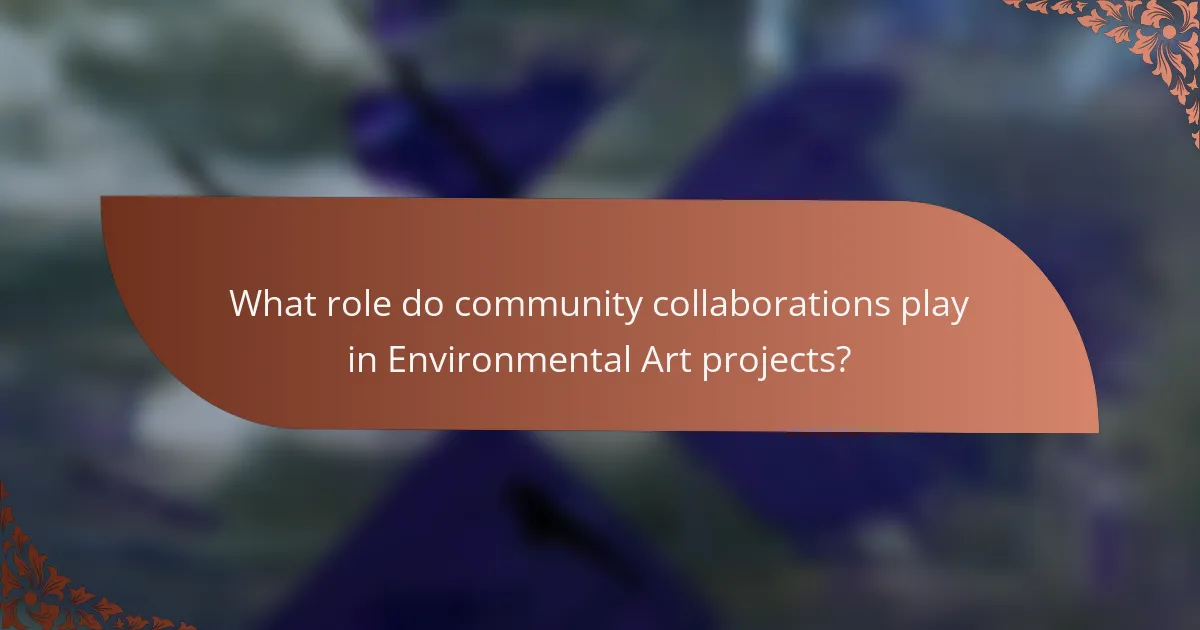
What role do community collaborations play in Environmental Art projects?
Community collaborations are vital in Environmental Art projects as they enhance engagement and foster local stewardship. These partnerships enable artists to incorporate diverse perspectives, addressing environmental issues more effectively. Collaborative efforts often lead to increased community awareness and participation, strengthening the social fabric around environmental concerns. Notably, projects that involve local stakeholders tend to resonate more deeply, creating lasting impacts on both the environment and the community.
How do local communities participate in environmental installations?
Local communities actively engage in environmental installations through collaboration, education, and advocacy. They often participate in projects that integrate art with ecological awareness, promoting sustainability and local culture.
Community members contribute ideas and resources, ensuring installations reflect their values and environment. For example, local artists may create site-specific works that highlight regional issues, fostering dialogue on conservation.
Workshops and events often involve residents in hands-on activities, enhancing their connection to the art and its message. These initiatives can lead to increased community pride and collective action toward environmental stewardship.
Overall, local participation in environmental art installations cultivates a sense of ownership and responsibility, reinforcing the relationship between art, nature, and society.
What are the benefits of engaging communities in Environmental Art?
Engaging communities in Environmental Art fosters social cohesion, raises environmental awareness, and encourages collective action. This practice empowers individuals to express their concerns and solutions creatively.
Community involvement in Environmental Art projects often leads to enhanced local identity and pride. Participants develop a sense of ownership over their environment, which can result in lasting commitment to sustainability initiatives.
Furthermore, these projects can serve as a platform for dialogue about environmental issues, bridging gaps between diverse groups. This collaboration can amplify voices that are often marginalized in traditional environmental discussions.
Finally, Environmental Art can catalyze educational opportunities, promoting environmental stewardship through interactive and engaging experiences. This multifaceted approach nurtures a more informed and active community.
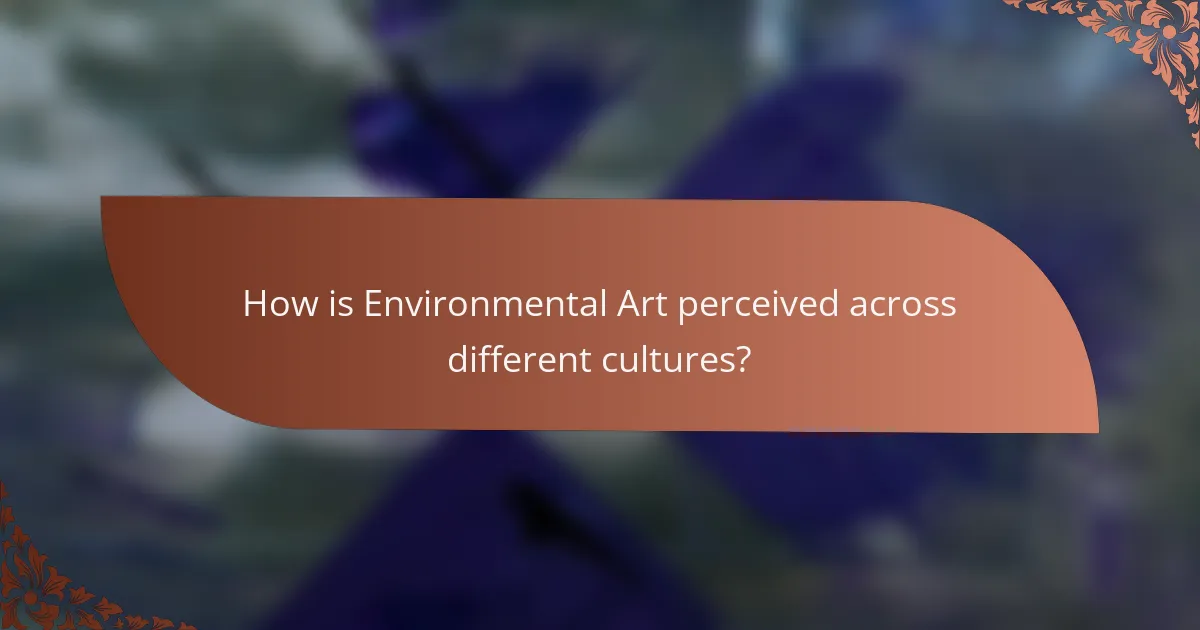
How is Environmental Art perceived across different cultures?
Environmental art is perceived differently across cultures, reflecting local values and environmental concerns. In Western cultures, it often emphasizes sustainability and critiques consumerism. In Indigenous cultures, environmental art may embody spiritual connections to nature and community.
For example, in Japan, environmental art integrates traditional aesthetics with natural elements, promoting harmony. In contrast, in African cultures, it often highlights community resilience and ecological issues. These varying perceptions showcase how environmental art serves as a social commentary, adapting to cultural contexts and addressing global challenges.
What are the common themes found in Environmental Art globally?
Environmental art globally often explores themes of nature, sustainability, and social activism. Artists use their work to comment on environmental issues, raise awareness, and inspire change. Common themes include the relationship between humans and nature, the impact of climate change, and the celebration of biodiversity. Collaborative projects often engage communities, fostering a sense of stewardship for the environment. Additionally, many artists utilize biodegradable materials and site-specific installations, emphasizing the transient nature of their work and its connection to the surrounding ecosystem.
How do cultural narratives influence the interpretation of Environmental Art?
Cultural narratives significantly shape how viewers interpret Environmental Art by framing their understanding of ecological issues. These narratives influence perceptions, encouraging engagement and reflection on environmental themes.
For instance, indigenous narratives often emphasize a deep connection to nature, which can enhance the appreciation of artworks that highlight sustainability. In contrast, contemporary narratives might focus on urbanization and industrialization, leading to different interpretations of similar artworks.
Moreover, cultural context can determine the emotional response to Environmental Art. In cultures prioritizing environmental stewardship, artworks may be viewed as urgent calls to action. Conversely, in cultures less engaged with ecological issues, the same works might be seen as mere aesthetic expressions.
Ultimately, the interplay between cultural narratives and Environmental Art fosters diverse interpretations, enriching the dialogue surrounding environmental challenges.
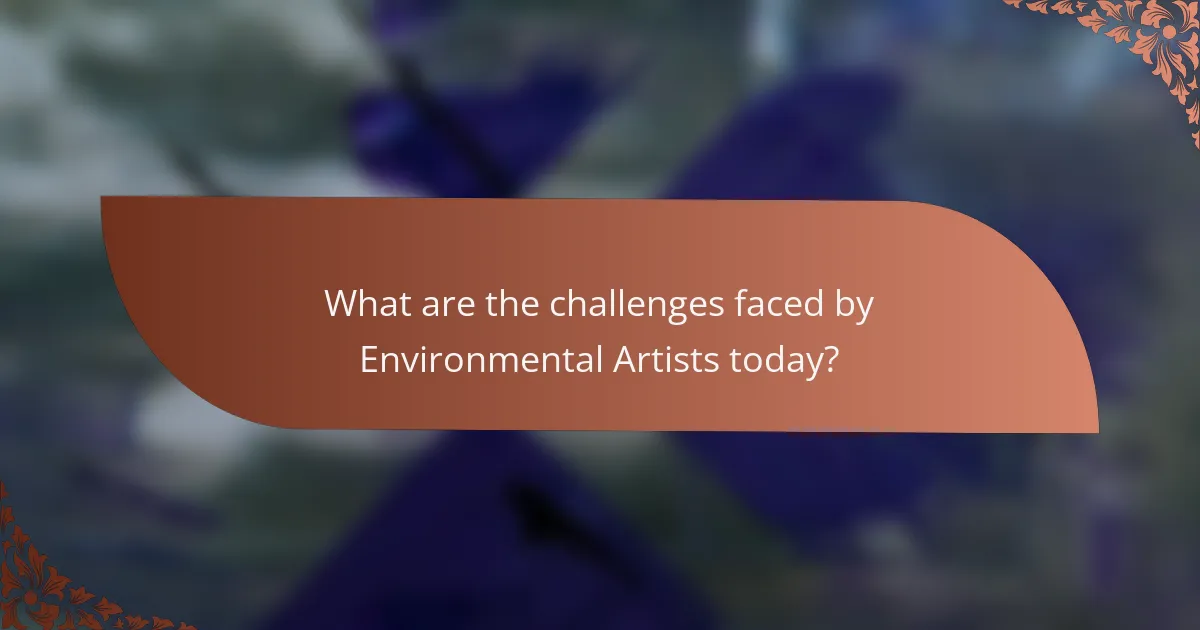
What are the challenges faced by Environmental Artists today?
Environmental artists today face significant challenges including funding limitations, environmental degradation, and public engagement. These obstacles hinder the visibility and impact of their work.
Limited funding restricts project scope and innovation. Many artists rely on grants, which are increasingly competitive. Environmental degradation poses a unique challenge, as artists often address issues that are worsening, complicating their message.
Public engagement remains crucial yet difficult. Artists strive to connect with audiences while competing against mainstream distractions. As a result, many seek innovative methods to convey their social commentary effectively.
The intersection of technology and art offers new opportunities but also presents challenges in maintaining authenticity. Balancing artistic integrity with the demands of digital platforms can be complex.
How do funding and resources impact Environmental Art initiatives?
Funding and resources significantly enhance the impact of Environmental Art initiatives. Adequate financial support allows artists to create larger, more ambitious projects that engage communities and raise awareness. Access to materials and technology also enables innovative approaches to environmental issues. For instance, collaborations with environmental organizations can amplify the message and reach of these artworks. Additionally, grants and sponsorships can facilitate public installations, making art accessible to broader audiences. Ultimately, the availability of resources shapes the effectiveness and visibility of Environmental Art in addressing ecological concerns.
What are the limitations of Environmental Art in driving social change?
Environmental Art faces limitations in driving social change due to its often ephemeral nature, limited audience reach, and reliance on aesthetic appeal. These factors can hinder its effectiveness in fostering long-term engagement and awareness. Additionally, the subjective interpretation of art may dilute its intended message, leading to varied responses among viewers. The focus on visual impact may overshadow the underlying environmental issues, reducing the urgency for action. Lastly, funding constraints can limit the scale and scope of projects, impacting their potential influence.
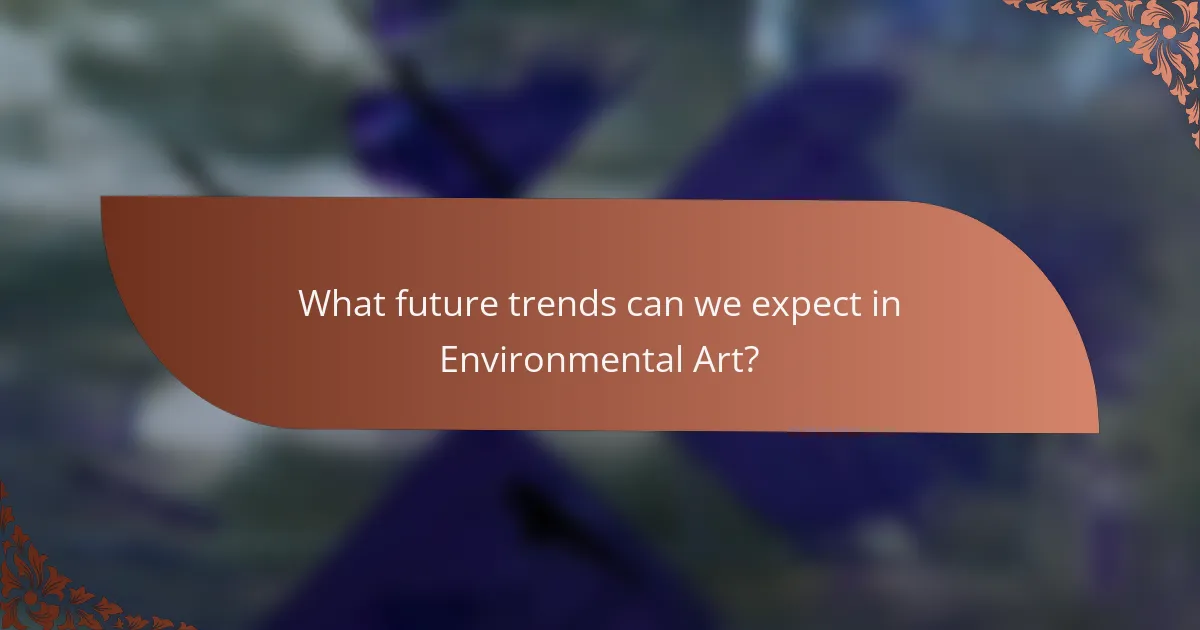
What future trends can we expect in Environmental Art?
Future trends in Environmental Art will increasingly focus on sustainability, technology integration, and community engagement. Artists will leverage biodegradable materials and renewable resources to create impactful works. Virtual reality and augmented reality will enhance viewer experiences, making art more accessible. Collaborative projects will foster social dialogue, addressing climate change and environmental justice. These trends reflect a growing awareness of ecological issues and the role of art in advocating for change.
How is technology influencing the creation of Environmental Art?
Technology significantly influences the creation of Environmental Art by enhancing artistic expression and engagement. Digital tools enable artists to visualize concepts and simulate environmental impacts. For example, augmented reality allows viewers to interact with art in real-time, fostering a deeper connection to environmental issues. Additionally, social media platforms amplify the reach of these artworks, promoting awareness and dialogue. Artists increasingly use data-driven techniques to depict climate change, making abstract issues more tangible. This intersection of technology and art creates innovative narratives that challenge perceptions and inspire action.
What role will social media play in the promotion of Environmental Art?
Social media will significantly enhance the promotion of Environmental Art by increasing visibility and engagement. Artists can share their work widely, fostering discussions about environmental issues. Platforms like Instagram and Twitter facilitate real-time interactions, allowing artists to connect with audiences and other creators globally. Furthermore, viral campaigns can raise awareness about specific environmental challenges, amplifying the impact of the art. Social media also supports diverse forms of content, such as videos and live streams, which can showcase the creative process and the message behind the art. This engagement can lead to community actions, collaborations, and greater support for environmental initiatives.
What best practices can artists adopt for impactful Environmental Art?
Artists can enhance the impact of Environmental Art by integrating community engagement, sustainability, and innovative materials. Engaging local communities fosters collaboration and amplifies social commentary. Using sustainable materials reduces ecological footprints, aligning art with environmental values. Innovative techniques, such as mixed media or interactive installations, capture attention and provoke thought. Prioritizing these practices enables artists to create meaningful connections between their work and environmental issues.
